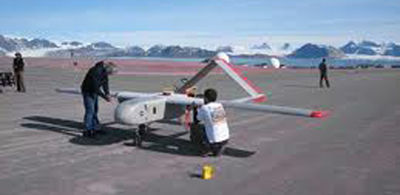NASA researchers have demonstrated the use of an unmanned aircraft to collect very low altitude airborne measurements of greenhouse gases at several sites in California and Nevada.
As Earth scientists strive to better understand sources and sinks of atmospheric greenhouse gases, a new aircraft capability developed at NASA Ames Research Center, Moffett Field, California has the potential to provide critical measurements of carbon fluxes.
The Sensor Integrated Environmental Remote Research Aircraft (SIERRA) team recently tested several instruments including a carbon dioxide, methane, and water vapor instrument as well as a wind probe for providing instantaneous measurements of greenhouse gas fluxes. SIERRA operates as part of a network of tools to observe carbon moving on our planet. The airborne system will assist scientists in their understanding of carbon dioxide cycling between the land, ocean and atmosphere. SIERRA complements other UAVs in the NASA science fleet by specializing in dangerous, low altitude missions that require significant payload capacity.
“Understanding the magnitude and location of carbon fluxes is important for improving our understanding of how ecosystems influence the composition of the atmosphere and the balance of climatically important gases,” said Laura Iraci, the principal investigator of the NASA Ames team. “Tower networks currently provide important information but their distribution is pre-defined. Aircraft can play an important role by enabling measurements where towers don’t or can’t exist, and in studying systems with features that move in time.”
“For example, in this desert environment, the areas of moist soil vary with season, and thus the sampling locations of interest will be different from season to season and year to year. The requirements for collecting measurements at very low altitudes (less than 100 ft) make it a dangerous proposition for pilots, so unmanned aircraft provide a great solution,” Iraci added.
The SIERRA team participated in a joint science mission between Japan and the United States in June of 2011 to calibrate and validate the JAXA GOSAT satellite, as well as to explore local sources and sinks of carbon dioxide and methane.
Understanding the distribution and cycling of carbon on Earth is critical to understanding how humans affect our ecosystem and how Earth changes due to climate variations. High frequency measurements enabled the use of the eddy covariance technique, which enables derivation of fluxes based on gas concentrations and vertical wind time series data. This technique is used in meteorology and widely used to estimate surface to atmosphere exchanges of heat, water and carbon dioxide.
The measurements demonstrated by the SIERRA team will directly support planned data products from several future NASA satellite missions including the Orbiting Carbon Observatory 2 and 3 and the Active Sensing of Carbon Dioxide Emissions over Nights, Days and Seasons (ASCENDS) mission.
Source: Press Release

